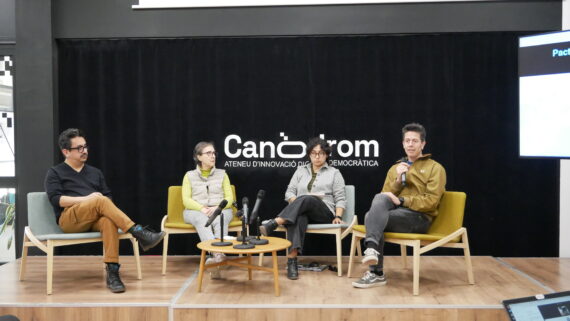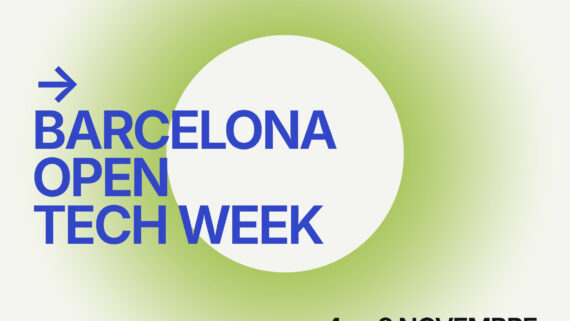
Artificial intelligence (AI) is not an ethereal cloud floating on the margins of physical reality. Behind its predictive models, virtual assistants, and promises of an automated future, there is a colossal material infrastructure: data centers that consume enormous amounts of energy and water, with a growing environmental and social impact worldwide.
This was the thread of the conversation moderated by journalist Carles Planas Bou (El Periódico) with researcher Ana Valdivia (University of Oxford) and activists Fanta and Aurora Gómez Delgado, from the collective ‘Tu Nube Seca Mi Río’, in a critical meeting that closed the Sustainable AI cycle questioning the current model of AI development.
When asking an AI burns the planet
A single query to ChatGPT can consume up to ten times more electricity than a Google search. This escalation of computational resources has increased as models have become larger and more complex. “In 2016, you trained algorithms from your computer; now you need the power of the ‘cloud’,” recalled Planas. But this cloud is not intangible: it is made of concrete, servers, and cooling systems that depend on large volumes of drinking water.
The data centers of large tech corporations are often cooled with water meant for human consumption. In Querétaro (Mexico), for example, giant pipes were built to carry water to a data center while local communities saw their reserves disappear. “Sometimes they say they use closed circuits, but they often use contaminated water, which then needs to be replaced because it evaporates,” warned Valdivia.
Invisible impacts and misleading numbers
According to an analysis published by The Guardian, the real emissions of the data centers owned by Google, Microsoft, Meta, and Apple could be up to 662% higher than what these companies officially report. This discrepancy is explained by the use of different calculation methods: while companies use a “market-based” approach —which includes buying renewable energy certificates (RECs) to offset their emissions—, the “location-based” approach considers the real emissions generated by the energy consumed, regardless of any compensation.
For example, Meta reported 273 metric tons of CO₂ emissions in 2022. But according to the location-based calculation, this figure rises to over 3.8 million tons. In the case of Microsoft, the official emissions were 280,782 tons, while the alternative calculation places them at 6.1 million. This opacity makes it extremely difficult to measure the real impact of the tech sector on the planet.
This lack of transparency is compounded by direct environmental effects. “They say they are ‘water-positive’, but in reality, they contaminate and return hot water to rivers, killing entire ecosystems,” denounces Aurora Gómez.
It is the case of Marseille, where local collectives warn that the water returned by the data centers is at such a high temperature that it severely affects species like shrimp and clams, essential for the ecological balance. “The effects are real, but very difficult to trace because the data is not public or transparent,” adds Ana Valdivia.
Energy, power, and dependence
Data centers have become critical infrastructures that alter the global energy map. They consume resources on a large scale and are often installed in rural or peripheral areas, where political costs and institutional resistance are lower. The companies behind them accumulate so much power that they can influence public policies or surpass the influence of local governments.
This dynamic creates what Fanta and Aurora define as “energy gentrification”. In Aragón, for example, there are towns where half of the energy goes to data centers. In some cases, priority contracts with companies make it impossible to build new housing due to the lack of available resources. “They sell us that digitization is progress, but these centers are a false promise: they promise jobs, but in reality, they are automated boxes with minimal human occupation,” warn the collective.
The push for AI also stretches the electricity demand to unsustainable limits. In Ireland, data centers consume between 20% and 30% of the entire electrical grid. In Virginia (USA), 90% of internet traffic passes through the same area. In Aragón, power outages and restrictions are increasing as these new digital infrastructures are being installed.
To sustain this model, large companies are already investing in nuclear energy. “Now it’s sold as the great solution, but we forget all the struggles to close plants. History repeats itself,” recalls Gómez.
Valdivia identifies three reasons why governments facilitate the implementation of these infrastructures: political reasons (projects that can be sold as innovative), infrastructure reasons (presented as clean energy), and the ‘Marina d’Or’ effect: once there is one, more come because the territory is already prepared.
Digital colonization and resistance
The territories chosen to host data centers are not neutral. They are selected from spaces with power imbalances, few transparency guarantees, and available natural resources. “It’s not that there is nothing, it’s that there are imbalances that allow it,” says Gómez. In Spain, there are already municipalities where data centers are being projected without the population being informed or consulted.
This model reinforces an extractivist logic: local resources are privatized and more dependent communities are left behind, with less sovereignty. “Politicians fall into the trap of ‘technological progress’, thinking it will bring jobs and innovation, when it often means exploitation and loss of control,” adds Planas.
Are there alternatives?
In this scenario, the question is not whether AI is efficient, but whether it is fair. We need moratoriums, regulation, transparency, and a clear commitment to technological decentralization. “AI should serve to solve real problems, not to generate cat memes while ecosystems are devoured,” says Fanta.
For Valdivia, AI is a reality we cannot ignore, but that must be governed: “AI is already here and we can’t stop it, but we can regulate it to make it fairer, socially and environmentally”
Gómez advocates limiting AI use to essential cases, avoiding its trivialization, and imagining other ways to connect. Possible digital utopias that involve community libraries, open source software, decentralized networks, and shared knowledge. “Because it’s not just about regulating what we have, but building alternatives that put life —not algorithms— at the center.”







